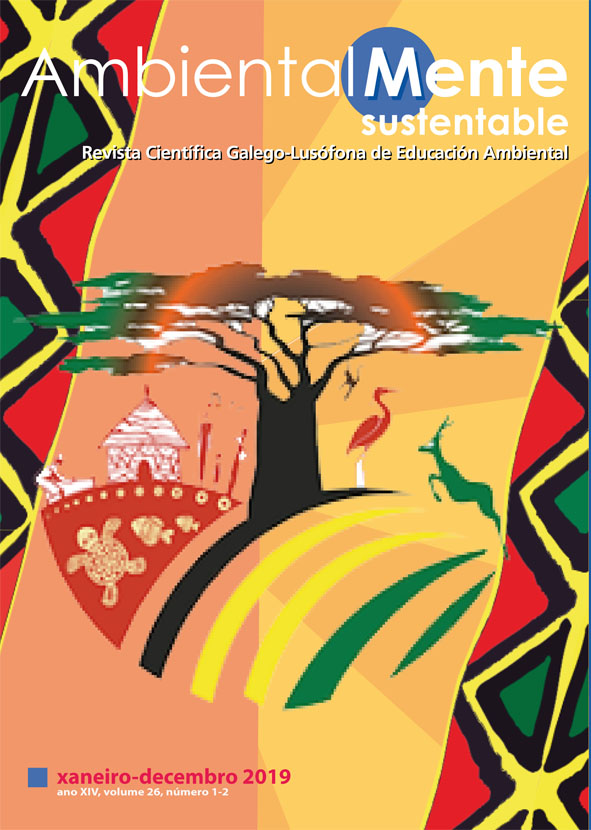Participatory Management of Natural Resources in the Bijagos Archipelago
DOI:
https://doi.org/10.17979/ams.2019.26.1-2.6553Keywords:
natural resources, sustainable development, participative management, environmental risks and vulnerabilitiesAbstract
The Bijagó society is structured around villages, political and economic units which have decision-making autonomy and an almost self-sufficiency. The clans are organized by sex and age classes, each playing a role and having duties in the community. Each island or village has its own forms of worship, either of idols or gods – iran – entities endowed with power to do good or evil and to which the prayers are addressed. Each island is considered property of the clan and of its iran as a guardian. There are areas that are considered sacred, which means no one can settle down there, being forbidden its continuous use. This is the case of certain spaces in Rubane, Enu, Orango and Carache. These areas are particularly important for the preservation of nature, since they combine various types of environments, from savannas and mangrove forests to sand banks, among the sea canals. This article aims at understanding how the management of land articulates with the division of spaces and at explaining how decisions regarding the preservation of the environment and natural resources are taken.
Downloads
References
Binet, Thomas, Pierre Failler e Andy Thorpe (2012). Migration of Senegalese fishers: a case for regional approach to management. Maritime Studies ,11, pp. 1-14
Campredon, Pierre e Paulo Catry (2018). Bijagos Archipelago (Guinea-Bissau), em C. Max Finlaysont, The Wetland Book, pp. 1-8. Springer Nature Switzerland AG.
Campredon, Pierre e François CUQ (2001). Artisanal fishing and coastal conservation in West Africa. Journal of Coastal Conservation, 7, 1, 91-100.
Có, Meio-Dia Sepa Maria Lé (1994). Mudanças recentes da linha de costa e dos ecossistemas costeiros da ilha de Bubaque (Arquipélago dos Bijagós). Dissertação de Mestrado. Faro: Universidade do Algarve.
Costa Correia, Edna Rita de Freitas da (2018). Small pelagics, predatory fish and seabirds: trophic and behavioural interactions in a marine protected area in Guinea-Bissau. Dissertação de Doutoramento. Lisboa/Aveiro: Faculdade de Ciências, Universidade de Lisboa/Departamento de Biologia, Universidade de Aveiro.
Cross, Helen (2016). “Displacement, disempowerment and corruption: challenges at the interface of fisheries, management and conservation in the Bijagós Archipelago, Guinea-Bissau”, Fauna & Flora International, 50 (4), pp. 693-701.
Cuq, François et al. (2011). Un système d’information géographique pour l’aide à la gestion intégrée de l’archipel des Bijagos (Guinée-Bissau): notice de la carte, constitution et exploitation du SIG. CNRS, Géosystèmes/INEP, IUCN.
Fernandes, Raúl Mendes (1995). “Contradições entre linhagens dominantes e classes de idades Bijagós”, Soronda - Revista de Estudos Guineenses, 20, pp. 73-79.
Fernandes, Raúl Mendes (1989). “O espaço e o tempo no sistema político bidjogó”, Soronda - Revista de Estudos Guineenses, 8, pp. 5-23.
Gallois-Duquette, Danielle (2000). “Introdução aos Bijagós da Guiné Bissau”, em Rita Sá Marques (Coord.), Na Presença dos Espíritos. Lisboa, Museu Nacional de Etnologia.
Kaczynski , Vlad M. e David L. Fluharty (2002). European policies in West Africa: Who benefits from fisheries agreements? Marine Policy, 2, 26, pp. 75-93.
Kyle, Steven (2009). The macroeconomic context for trade in Guinea-Bissau. Working Paper, Department of Applied Economics and Management. New York: Cornell University, Ithaca.
Madeira, João Paulo Carvalho e Branco (2009). Gestão do Espaço e da Propriedade Tradicional no Arquipélago dos Bijagós. Dissertação de Mestrado em Estudos Africanos. Lisboa: ISCSP.
Maretti, Cláudio Carrera (2003). “The Bijagós Islands – culture, resistance and conservation”, Policy Matters, 12, pp. 121-131.
Njock, Jean-Calvin e Lena Westlund (2010). “Migration, resource management and global change: experiences from fishing communities in West and Central Africa”, Marine Policy, 4, 34, pp. 752-760.
Oliveira, Sandra (2009). Educação para Todos: Urok – Arquipélago dos Bijagós - Guiné-Bissau. Lisboa: IMVF e Tiniguena.
Sais, Abílio Rachid e Alexandre ABREU (2011). A Economia Local da Área Marinha Protegida da Comunidade de UROK: Dinâmicas, Constrangimentos e Potencialidades. Lisboa: IMVF.
Silva, Dilma de Melo (2000). Por entre as Dórcades Encantadas: Os Bijagó da Guiné-Bissau. São Paulo: Terceira Margem.
Tous, P., M. Ducrocq, D. Bucal e E. Feron (1998). “Shark populations are possibly under serious threat in the Bijagos archipelago (Biosphere Reserve), Guinea Bissau”, West Africa. Shark News. Newsletter of the IUCN Shark Specialist Group. Newbury, Berkshire, UK.: Nature Conservation Bureau Limited, 10, p. 4.
Downloads
Published
How to Cite
Issue
Section
License
The papers published in this journal are licensed under a Creative Commons Attribution-ShareAlike 4.0 International License.
Authors grant the right of first publication to the ambientalMENTEsustentable, which may publish in any language and format as well as publish and distribute their whole or partial content by any technologically available means and via data base.
Authors are allowed and encouraged to disseminate the articles accepted for publication on personal or institutional websites, before and after their publication, provided it is clearly stated that the work belongs to this journal and all bibliographic data are provided along with access to the document.



